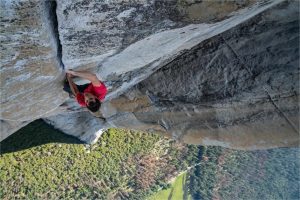Nervous? How to keep your calm, even when presenting under extreme pressure.

Are you a bundle of nerves in front of an audience? Do you toss and turn the night before? Dreading a black-out or red blotches appearing on your neck? Perhaps things actually go better than you had anticipated. As nervous as you’ve ever been, you’ve probably never felt the same amount of stress as Alex Honnold.
In 2017, Alex scaled El Capitan, a 900-meter rock formation in Yosemite National Park (United States). Without the use of ropes. One slip, one single misstep, and he would fall to his death. Nerve-racking, to say the least.
How does he handle nerves?
And what can this experience teach us about keeping our presentation nerves under control? Take a look at Alex’ excellent TED talk. Although I am a climber myself, just watching the intro video to his talk gives me sweaty palms. And listening to him describe the feeling of climbing up without a rope makes me extremely jittery.
You just want to scream out: “If it is that stressful, HOW DO YOU KEEP YOUR CALM?”
How does Alex contain his nerves, being just a single misstep away from falling to his death far below?
1. He trains and memorizes his steps.
Alex first scaled the rock face fifty times using ropes, before attempting this without. He also practiced climbing the more challenging bits separately, attached to a rope. Until he knew them by heart. Thanks to this intense training:
- he knows where the challenging bits are,
- he is aware of every single step of the track,
- he is much more at ease during his climb
At the start of his presentation he describes another one of his climbs (the Half Dome) that he does without a rope. For this climb he adjusted his plan last-minute and embarked on it without much training. The result? At a difficult bit he panicked. When he reached the summit, he felt terrible and was completely stressed out.
View your presentation as an ascent without a rope. By practicing:
- you will know where the difficult bits are (the areas where your explanation will be a bit more rigid),
- you will know every next step (and won’t continuously have to check which slide is up next),
- you will be less stressed out when you reach the end of your presentation.
If you show up at the start with very little preparation, you will be more tense and your sentences may come out choppier. You will reach the summit, but just like Alex, feeling terrible and more stressed than necessary.
2. He visualizes his ideal scenario, as well as the obstacles.
Whenever Alex is not climbing, he is thinking about his next ascent. In his mind he envisions every step he will take, over and over again. He memorizes the order of the steps (thousands of actions for a 900-meter rock wall), pretty much allowing him to climb up blindly.
Additionally, he visualizes the emotional side. What if he suddenly tenses up, or becomes tired? How should he handle that? He learns to mentally view difficult bits from different angles. In his mind he can still afford to make mistakes. Once he is hanging from that cliff, all bets are off.
The power of visualization, also when presenting. Visualize your ideal scenario. Imagine yourself standing on stage confidently with everything going as planned. You are enjoying giving this presentation and your audience is fully engaged.
Chances are that your final presentation will not be as ideal as what you had imagined, but by visualizing over and over again what it would look like in an ideal scenario, you will adjust your perception. You will no longer view your audience as a threat, but rather as a group of people listening to you with an open mind.
Visualize the obstacles too. Imagine what you would do if anything were to go wrong. What if you lose your train of thought, your video won’t play, or your slide controller runs out of battery? What if you are asked a difficult question you don’t know the answer to? Think of your actions beforehand. Answer the questions you could be asked. In your head you can make mistakes, but not on stage. Just like on a rock wall.
It looks so easy
After one of his ascents without rope, Alex has finally reached the summit. The people walking around on the top of the mountain pay no attention to him. They are focused on the climbers reaching the top with ropes attached to them. After all, Alex doesn’t look like a real climber without a rope. Nobody would guess that he has just overcome immense fears and achieved a tremendous accomplishment.
Make that your ideal scenario: conquer those nerves and climb that mountain, not letting your audience in on the effort that went into it.
————————-
Don’t have the time to look at the complete presentation of Alex? National Geographic made a movie about his climb that leaves you with sweaty palms as well. Watch the impressive trailer:
[For the Belgians among you: El Capitan is the rock face that Tom Waes climbed several years ago – with a rope and guides – for the television program Tomtesterom.]
Photo: National Geographic